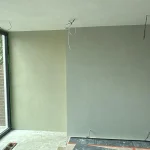What Causes Yellowing Following the Application of Solvent Based Sealer?
MaxiPur is an incredibly effective solvent based polyurethane sealer, it’s fantastically good at repelling water-based liquids and chemicals.
Because it is a strong solvent, it will dissolve a number of materials when it is in liquid form.
Solvent sealers, like MaxiPur, can only be applied with rollers that are suitable for use with solvents. Trays and roller cages must also be completely clean and free from rust.
Rollers that are suitable for use with Solvents, have been developed specifically to resist dissolution into solvent. This is important, because if material from the roller dissolves in the solvent it can transfer colour to the liquid solvent. Often, this taints the solvent with a yellow hue, which in turn is transferred onto the surface of the microcement in the form of a yellow film or yellow patches.
How Can I Avoid Yellowing on the Surface When Using Solvent Based Sealers?
It’s important that you purchase rollers that are suitable for use with solvents. These are available from most good decorator centres. Take care to check that the rollers are recommended for use with solvent not just “Solvent Resistant” as these don’t always have sufficient protection against dissolution.
How Do I Repair the Microcement After It Has Yellowed?
You can try to sand the surface to remove the sealer, for small areas, this may be the best approach. Once the sealer has been removed, it will need resealing using correct rollers or an alternative sealer, like AquaMax Pro.
In our experience, on larger areas, sanding the sealer off can be a very time-consuming process. And you may find that Recoating the Microcement is the most viable option.

